Nanocrystalline TiO2 Sensitive Layer for Plasmonic Hydrogen Sensing
Abstract
1. Introduction
2. Materials and Methods
2.1. Plasmonic Gratings Fabrication
2.2. Au Monolayer Fabrication and TiO2 and SiO2 Film Deposition
2.3. Optical Characterization and Gas Sensing Setup
2.4. Plasmonic Grating Spectra Characterization
3. Results
Hydrogen Detection Experiments
4. Discussion
4.1. Model for Permittivity Variation
4.2. Model for H2-TiO2 Interaction
4.3. Discussion of the Au Monolayer Sensor
5. Conclusions
Author Contributions
Funding
Conflicts of Interest
References
- Homola, J. Surface Plasmon Resonance Sensors for Detection of Chemical and Biological Species. Chem. Rev. 2008, 108, 462–493. [Google Scholar] [CrossRef] [PubMed]
- Shankaran, D.R.; Gobiand, K.V.; Miura, N. Recent advancements in surface plasmon resonance immunosensors for detection of small molecules of biomedical, food and environmental interest. Sens. Actuators B 2007, 121, 158–177. [Google Scholar] [CrossRef]
- Ince, R.; Narayanaswamy, R. Analysis of the performance of interferometry, surface plasmon resonance and luminescence as biosensors and chemosensors. Anal. Chim. Acta 2006, 569, 1–20. [Google Scholar] [CrossRef]
- Habauzit, D.; Chopineau, J.; Roig, B. SPR-based biosensors: A tool for biodetection of hormonal compounds. Anal. Bioanal. Chem. 2007, 387, 1215–1223. [Google Scholar] [CrossRef] [PubMed]
- Singh, P. SPR Biosensors: Historical Perspectives and Current Challenges. Sens. Actuators B 2016, 229, 110–130. [Google Scholar] [CrossRef]
- Nooke, A.; Beck, U.; Hertwig, A.; Krause, A.; Krüger, H.; Lohse, V.; Negendank, D.; Steinbach, J. On the application of gold based SPR sensors for the detection of hazardous gases. Sens. Actuators B 2010, 149, 194–198. [Google Scholar] [CrossRef]
- Brigo, L.; Cittadini, M.; Artiglia, L.; Rizzi, G.A.; Granozzi, G.; Guglielmi, M.; Martucci, A.; Brusatin, G. Xylene sensing properties of aryl-bridged polysilsesquioxane thin films coupled to gold nanoparticles. J. Mater. Chem. C 2013, 1, 4252–4260. [Google Scholar] [CrossRef]
- Brigo, L.; Gazzola, E.; Cittadini, M.; Zilio, P.; Zacco, G.; Romanato, F.; Martucci, A.; Guglielmi, M.; Brusatin, G. Short and long range surface plasmon polariton waveguides for xylene sensing. Nanotechnology 2013, 24, 155502. [Google Scholar] [CrossRef]
- Manera, M.G.; Spadavecchia, J.; Buso, D.; de Julián Fernández, C.; Mattei, G.; Martucci, A.; Mulvaney, P.; Pérez-Juste, J.; Rella, R.; Vasanelli, L.; et al. Optical gas sensing of TiO2 and TiO2/Au nanocomposite thin films. Sens. Actuators B 2008, 132, 107–115. [Google Scholar] [CrossRef]
- Mejía-Salazar, J.R.; Oliveira, O.N., Jr. Plasmonic Biosensing. Chem. Rev. 2018, 118, 10617–10625. [Google Scholar] [CrossRef]
- Csáki, A.; Stranik, O.; Fritzsche, W. Localized surface plasmon resonance based biosensing. Expert. Rev. Mol. Diagn. 2018, 18, 279–296. [Google Scholar] [CrossRef] [PubMed]
- Buso, D.; Post, M.; Cantalini, C.; Mulvaney, P.; Martucci, A. Gold Nanoparticle-Doped TiO2 Semiconductor Thin Films: Gas Sensing Properties. Adv. Funct. Mater. 2008, 18, 3843–3849. [Google Scholar] [CrossRef]
- Ando, M.; Kobayashi, T.; Haruta, M. Enhancement in the optical CO sensitivity of NiO film by the deposition of ultrafine gold particles. J. Chem. Soc. Faraday Trans. 1994, 90, 1011–1013. [Google Scholar] [CrossRef]
- Ando, M.; Kobayashi, T.; Iijima, S.; Haruta, M. Optical recognition of CO and H2 by use of gas-sensitive Au–Co3O4 composite films. J. Mater. Chem. 1997, 7, 1779–1783. [Google Scholar] [CrossRef]
- Göpel, W.; Rocker, G.; Feierabend, R. Intrinsic defects of TiO2(110): Interaction with chemisorbed O2, H2, CO, and CO2. Phys. Rev. B 1983, 28, 3427–3438. [Google Scholar] [CrossRef]
- Van Hippel, A.R.; Kalnajs, J.; Westphal, W.B. Protons, dipoles, and charge carriers in rutile. J. Phys. Chem. Solids 1962, 23, 779. [Google Scholar] [CrossRef]
- Birkefeld, L.D.; Azad, A.M.; Akbar, S.A. Carbon Monoxide and Hydrogen Detection by Anatase Modification of Titanium Dioxide. J. Am. Ceram. Soc. 1992, 75, 2964–2968. [Google Scholar] [CrossRef]
- Mather, G.C.; Marques, F.M.B.; Frade, J.R. Detection mechanism of TiO2-based ceramic H2 sensors. J. Eur. Ceram. Soc. 1999, 19, 887–891. [Google Scholar] [CrossRef]
- Mukherjee, T.; Hazra, S.K.; Basu, S. Porous Titania Thin Films Grown by Anodic Oxidation for Hydrogen Sensors. Mater. Manuf. Process. 2006, 21, 247–251. [Google Scholar] [CrossRef]
- Della Gaspera, E.; Bersani, M.; Mattei, G.; Nguyen, T.L.; Mulvaney, P.; Martucci, A. Cooperative effect of Au and Pt inside TiO2 matrix for optical hydrogen detection at room temperature using surface plasmon spectroscopy. Nanoscale 2012, 4, 5972–5979. [Google Scholar] [CrossRef]
- Baltrus, J.P.; Ohodnicki, P.R.; Joy, N.A.; Carpenter, M.A. Examination of charge transfer in Au/YSZ for high-temperature optical gas sensing. Appl. Surf. Sci. 2014, 313, 19–25. [Google Scholar] [CrossRef]
- Larsson, E.M.; Langhammer, C.; Zoric, I.; Kasemo, B. Nanoplasmonic Probes of Catalytic Reactions. Science 2009, 326, 1091–1094. [Google Scholar] [CrossRef] [PubMed]
- Kale, M.J.; Avanesian, T.; Christopher, P. Direct Photocatalysis by Plasmonic Nanostructures. ACS Catal. 2014, 4, 116–128. [Google Scholar] [CrossRef]
- Linic, S.; Aslam, U.; Boerigter, C.; Morabito, M. Photochemical transformations on plasmonic metal nanoparticles. Nat. Mater. 2015, 14, 567–576. [Google Scholar] [CrossRef]
- Boerigter, C.; Campana, R.; Morabito, M.; Linic, S. Evidence and implications of direct charge excitation as the dominant mechanism in plasmon-mediated photocatalysis. Nat. Commun. 2016, 7, 10545. [Google Scholar] [CrossRef]
- Panayotov, D.A.; Morris, J.R. Surface chemistry of Au/TiO2: Thermally and photolytically activated reactions. Surf. Sci. Rep. 2016, 71, 77–271. [Google Scholar] [CrossRef]
- Zhang, Y.; He, S.; Guo, W.; Hu, Y.; Huang, J.; Mulcahy, J.R.; Wei, W.D. Surface-Plasmon-Driven Hot Electron Photochemistry. Chem. Rev. 2018, 118, 2927–2954. [Google Scholar] [CrossRef]
- Mukherjee, S.; Libisch, F.; Large, N.; Neumann, O.; Brown, L.V.; Cheng, J.; Lassiter, J.B.; Carter, E.A.; Nordlander, P.; Halas, N.J. Hot Electrons Do the Impossible: Plasmon-Induced Dissociation of H2 on Au. Nano Lett. 2013, 13, 240–247. [Google Scholar] [CrossRef]
- Sil, D.; Gilroy, K.D.; Niaux, A.; Boulesbaa, A.; Neretina, S.; Borguet, E. Seeing Is Believing: Hot Electron Based Gold Nanoplasmonic Optical Hydrogen Sensor. ACS Nano 2014, 8, 7755–7762. [Google Scholar] [CrossRef]
- Mukherjee, S.; Zhou, L.; Goodman, A.M.; Large, N.; Ayala-Orozco, C.; Zhang, Y.; Nordlander, P.; Halas, N.J. Hot-Electron-Induced Dissociation of H2 on Gold Nanoparticles Supported on SiO2. J. Am. Chem. Soc. 2014, 136, 64–67. [Google Scholar] [CrossRef]
- Collins, S.S.E.; Cittadini, M.; Pecharromán, C.; Martucci, A.; Mulvaney, P. Hydrogen Spillover between Single Gold Nanorods and Metal Oxide Supports: A Surface Plasmon Spectroscopy Study. ACS Nano 2015, 9, 7846–7856. [Google Scholar] [CrossRef] [PubMed]
- Zacco, G.; Romanato, F.; Sonato, A.; Sammito, D.; Ruffato, G.; Morpurgo, M.; Silvestri, D.; Carli, M.; Schiavuta, P.; Brusatin, G. Sinusoidal plasmonic crystals for bio-detection sensors. Microelectron. Eng. 2011, 88, 1898–1901. [Google Scholar] [CrossRef]
- Antonello, A.; Jia, B.; He, Z.; Buso, D.; Perotto, D.; Brigo, L.; Brusatin, G.; Guglielmi, M.; Gu, M.; Martucci, A. Optimized Electroless Silver Coating for Optical and Plasmonic Applications. Plasmonics 2012, 7, 633–639. [Google Scholar] [CrossRef]
- Loy, D.A.; Shea, K.J. Bridged Polysilsesquioxanes. Highly Porous Hybrid Organic-Inorganic Materials. Chem. Rev. 1995, 95, 1431–1442. [Google Scholar] [CrossRef]
- Brigo, L.; Grenci, G.; Carpentiero, A.; Pistore, A.; Tormen, M.; Guglielmi, M.; Brusatin, G. Positive resist for UV and X-ray lithography synthesized through sol–gel chemistry. J. Sol-Gel Sci. Technol. 2011, 60, 400–407. [Google Scholar] [CrossRef]
- Ong, B.H.; Yuan, X.; Tjin, S.C. Bimetallic Silver–Gold Film Waveguide Surface Plasmon Resonance Sensor. Fiber Integr. Opt. 2007, 26, 229–240. [Google Scholar] [CrossRef]
- Della Gaspera, E.; Karg, M.; Baldauf, J.; Jasieniak, J.; Maggioni, G.; Martucci, A. Au Nanoparticle Monolayers Covered with Sol–Gel Oxide Thin Films: Optical and Morphological Study. Langmuir 2011, 27, 13739–13747. [Google Scholar] [CrossRef]
- Antonello, A.; Brusatin, G.; Guglielmi, M.; Bello, V.; Mattei, G.; Zacco, G.; Martucci, A. Nanocomposites of titania and hybrid matrix with high refractive index. J. Nanopart. Res. 2011, 13, 1697–1708. [Google Scholar] [CrossRef]
- Buso, D.; Palmer, L.; Bello, V.; Mattei, G.; Post, M.; Mulvaney, P.; Martucci, A. Self-assembled gold nanoparticle monolayers in sol–gel matrices: Synthesis and gas sensing applications. J. Mater. Chem. 2009, 19, 2051–2057. [Google Scholar] [CrossRef]
- Fujiwara, H. Spectroscopic Ellipsometry: Principles and Applications; John Wiley & Sons: Chichester, UK, 2007. [Google Scholar]
- Hooper, I.R.; Sambles, J.R. Surface plasmon polaritons on thin-slab metal gratings. Phys. Rev. B 2003, 67, 235404. [Google Scholar] [CrossRef]
- Economou, E.N. Surface Plasmons in Thin Films. Phys. Rev. 1969, 182, 539–554. [Google Scholar] [CrossRef]
- Sarid, D. Long-Range Surface-Plasma Waves on Very Thin Metal Films. Phys. Rev. Lett. 1981, 47, 1927–1930. [Google Scholar] [CrossRef]
- Burke, J.J.; Stegeman, G.I.; Tamir, T. Surface-polariton-like waves guided by thin, lossy metal films. Phys. Rev. B 1986, 33, 5186. [Google Scholar] [CrossRef] [PubMed]
- Jung, L.S.; Campbell, C.T.; Chinowsky, T.M.; Mar, M.N.; Yee, S.S. Quantitative Interpretation of the Response of Surface Plasmon Resonance Sensors to Adsorbed Films. Langmuir 1998, 14, 5636–5648. [Google Scholar] [CrossRef]
- Ruffato, G.; Romanato, F. Near-field numerical analysis of surface plasmon polariton propagation on metallic gratings. COMPEL 2013, 32, 1779–1792. [Google Scholar] [CrossRef]
- Chandezon, J.; Maystre, D.; Raoult, G. A new theoretical method for diffraction gratings and its numerical application. J. Opt. 1980, 11, 235–241. [Google Scholar] [CrossRef]
- Gazzola, E.; Brigo, L.; Zacco, G.; Zilio, P.; Ruffato, G.; Brusatin, G.; Romanato, F. Coupled SPP Modes on 1D Plasmonic Gratings in Conical Mounting. Plasmonics 2014, 9, 867–876. [Google Scholar] [CrossRef]
- Yeatman, E.M. Resolution and sensitivity in surface plasmon microscopy and sensing. Biosens. Bioelectron. 1996, 11, 635–649. [Google Scholar] [CrossRef]
- Fox, M. Optical Properties of Solids, 2nd ed.; Oxford University Press: New York, NY, USA, 2010. [Google Scholar]
- Klingshirn, C. Semiconductor Optics, 2nd ed.; Springer: Berlin, Germany, 2005. [Google Scholar]
- Dueñas, S.; Castán, H.; García, H.; San Andrés, E.; Toledano-Luque, M.; Mártil, I.; González-Díaz, G.; Kukli, K.; Uustare, T.; Aarik, J. A comparative study of the electrical properties of TiO2 films grown by high-pressure reactive sputtering and atomic layer deposition. Semicond. Sci. Technol. 2005, 20, 1044–1051. [Google Scholar] [CrossRef]
- Enright, B.; Fitzmaurice, D. Spectroscopic Determination of Electron and Hole Effective Masses in a Nanocrystalline Semiconductor Film. J. Phys. Chem. 1996, 100, 1027–1035. [Google Scholar] [CrossRef]
- Tang, H.; Lévi, F.; Berger, H.; Schmid, P.E. Urbach tail of anatase TiO2. Phys. Rev. B 1995, 52, 7771–7774. [Google Scholar] [CrossRef] [PubMed]
- Pecharroman, C.; Della Gaspera, E.; Martucci, A.; Escoba-Galindod, R.; Mulvaney, P. Determination of the Optical Constants of Gold Nanoparticles from Thin-Film Spectra. J. Phys. Chem. C 2015, 119, 9450–9459. [Google Scholar] [CrossRef]
- Diebold, U. The surface science of titanium dioxide. Surf. Sci. Rep. 2003, 48, 53–229. [Google Scholar] [CrossRef]
- Gordon, T.R.; Cargnello, M.; Paik, T.; Mangolini, F.; Weber, R.T.; Fornasiero, P.; Murray, C.B. Nonaqueous Synthesis of TiO2 Nanocrystals Using TiF4 to Engineer Morphology, Oxygen Vacancy Concentration, and Photocatalytic Activity. J. Am. Chem. Soc. 2012, 134, 6751–6761. [Google Scholar] [CrossRef] [PubMed]
- Christopher, P.; Xin, H.; Linic, S. Visible-light-enhanced catalytic oxidation reactions on plasmonic silver nanostructures. Nat. Chem. 2011, 3, 467–472. [Google Scholar] [CrossRef]
- Nishijima, Y.; Ueno, K.; Yokota, Y.; Murakoshi, K.; Misawa, H. Plasmon-Assisted Photocurrent Generation from Visible to Near-Infrared Wavelength Using a Au-Nanorods/TiO2 Electrode. J. Phys. Chem. Lett. 2010, 1, 2031–2036. [Google Scholar] [CrossRef]
- Christopher, P.; Xin, H.; Marimuthu, A.; Linic, S. Singular characteristics and unique chemical bond activation mechanisms of photocatalytic reactions on plasmonic nanostructures. Nat. Mater. 2012, 11, 1044–1050. [Google Scholar] [CrossRef] [PubMed]

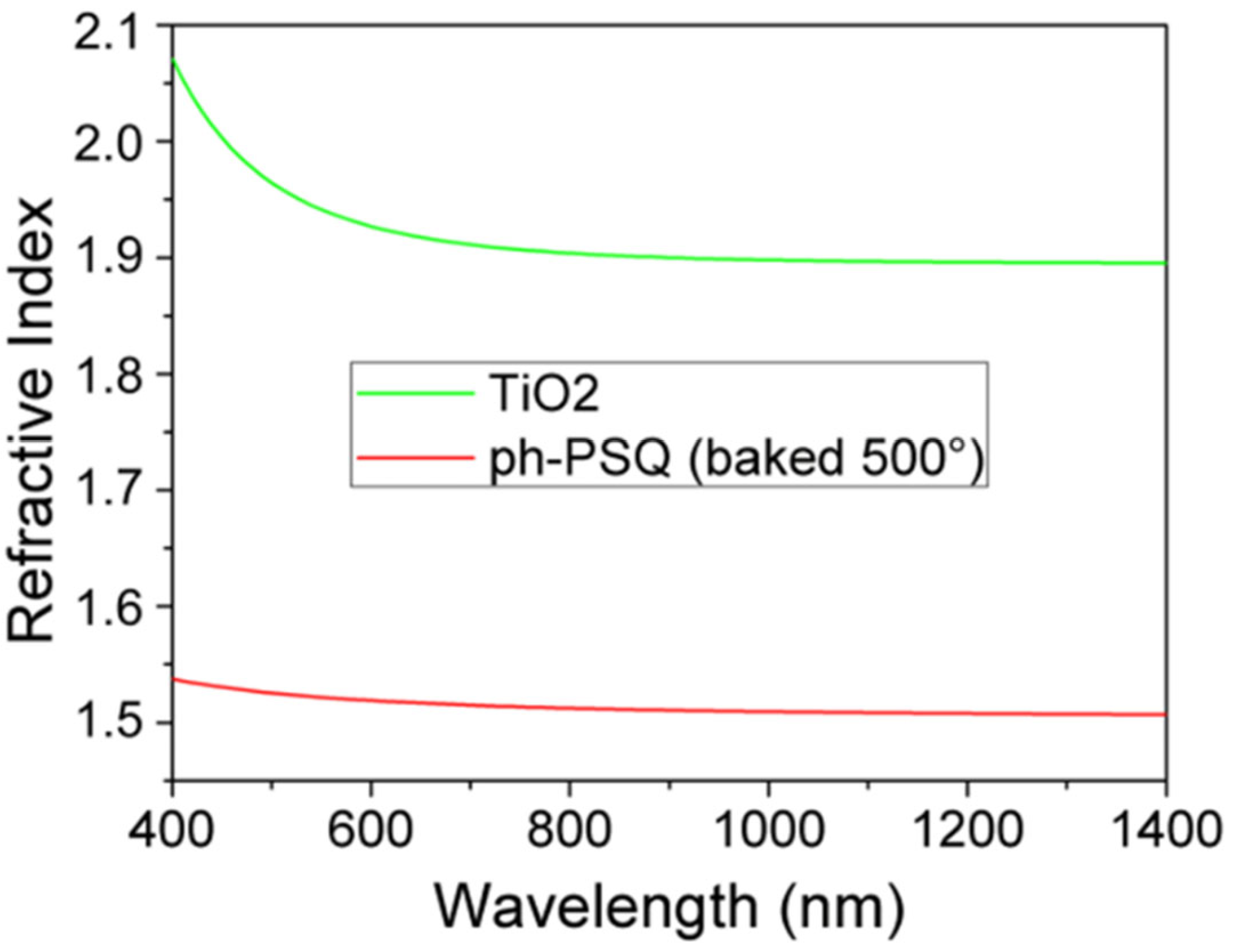
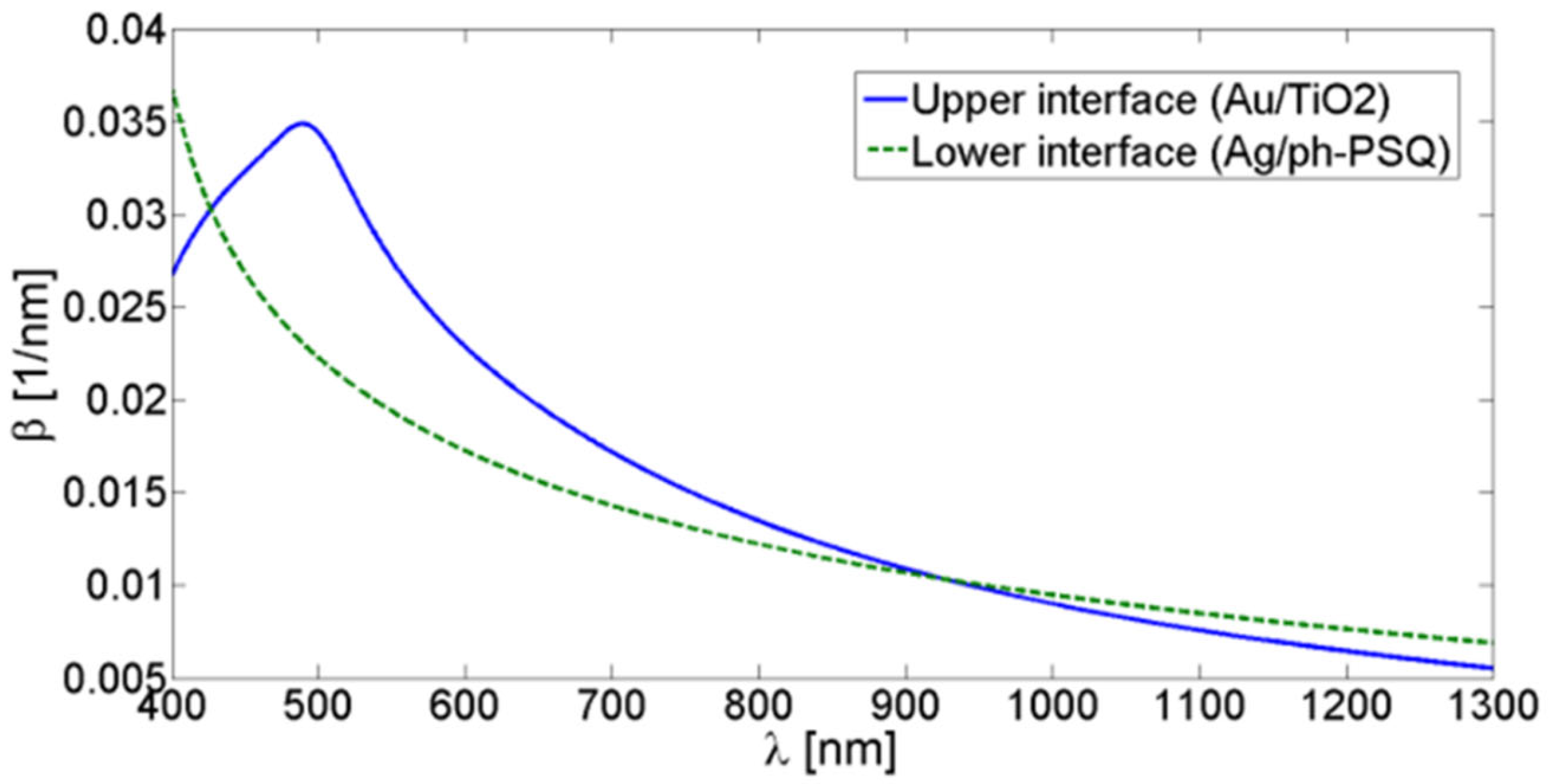
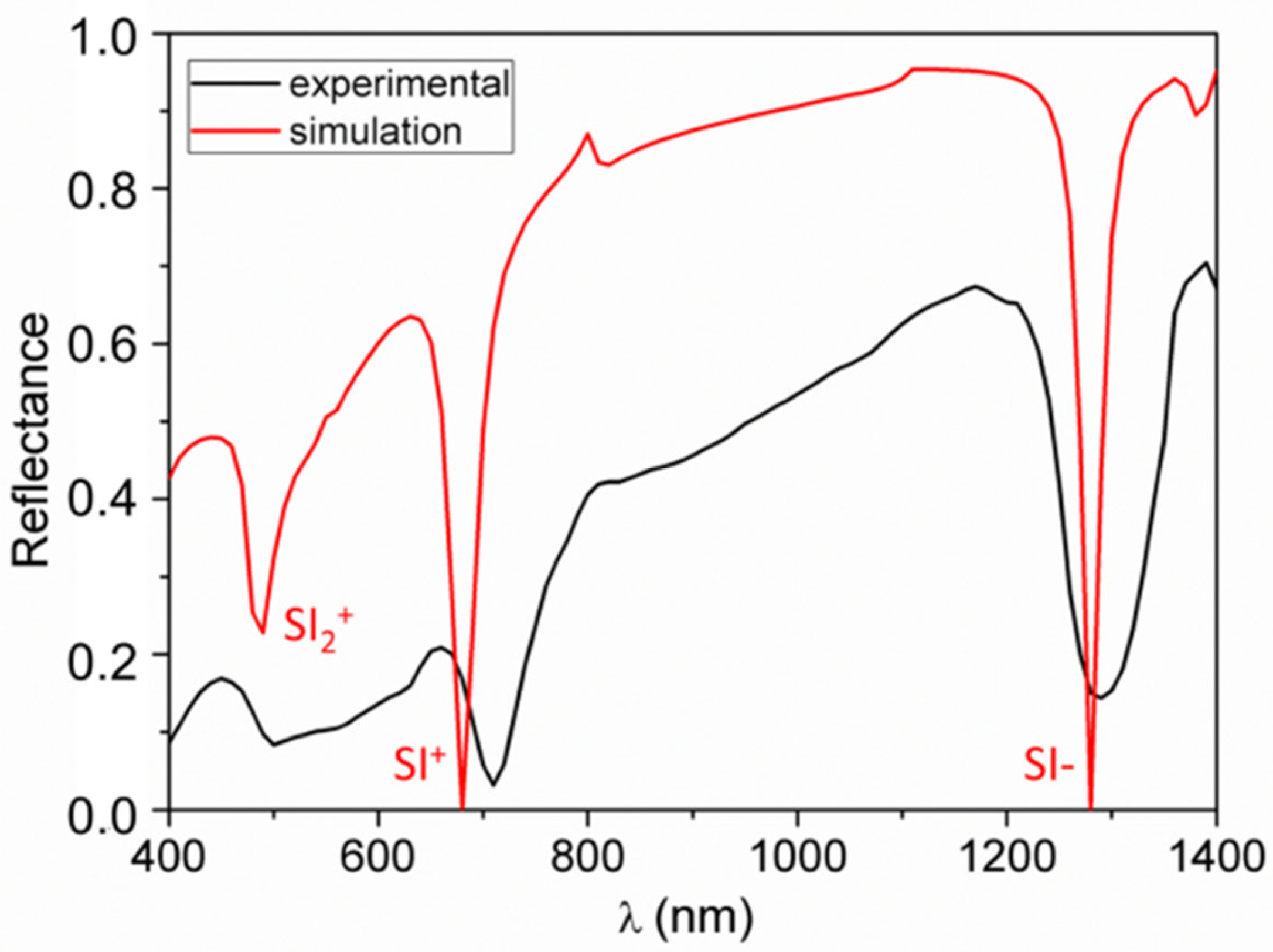
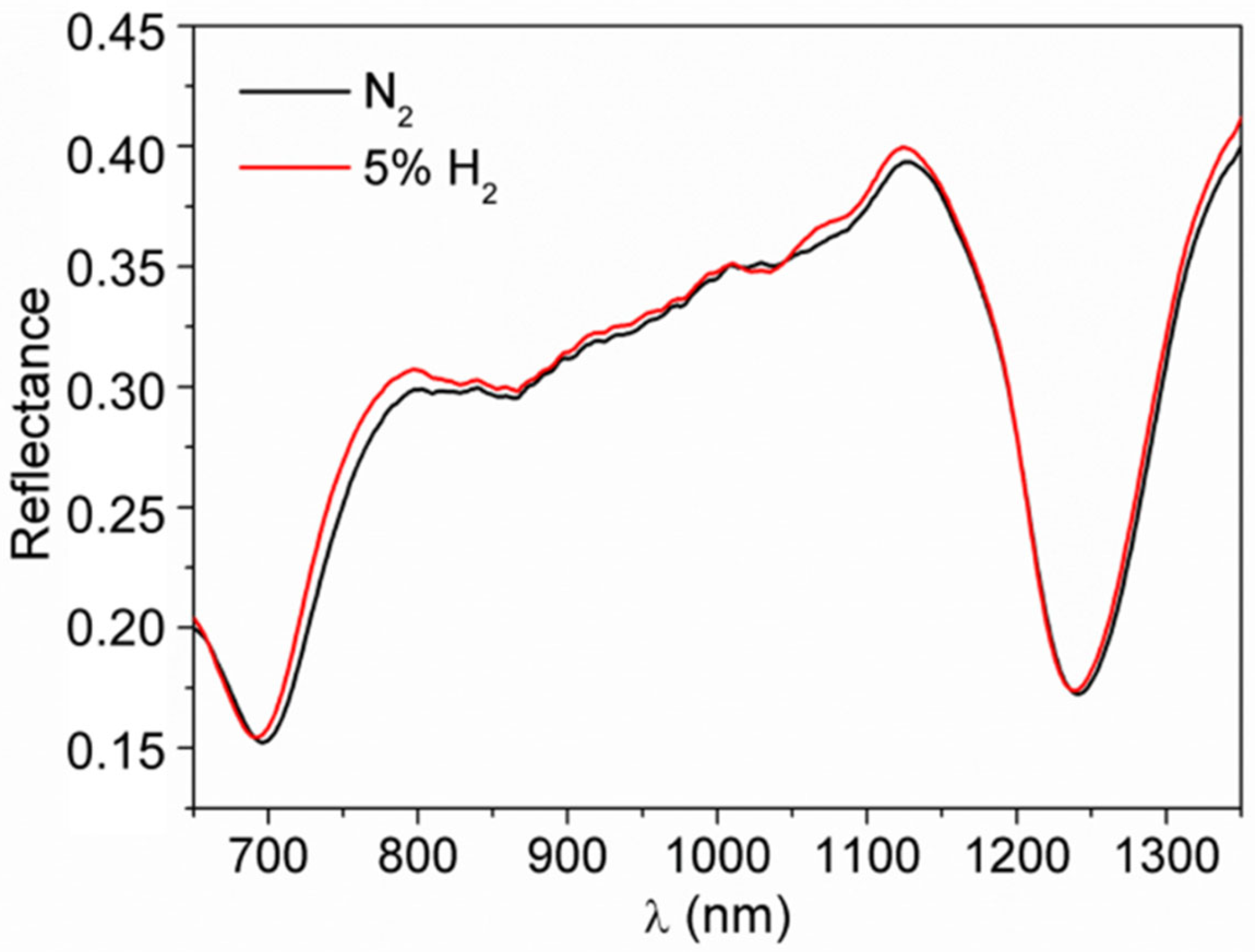
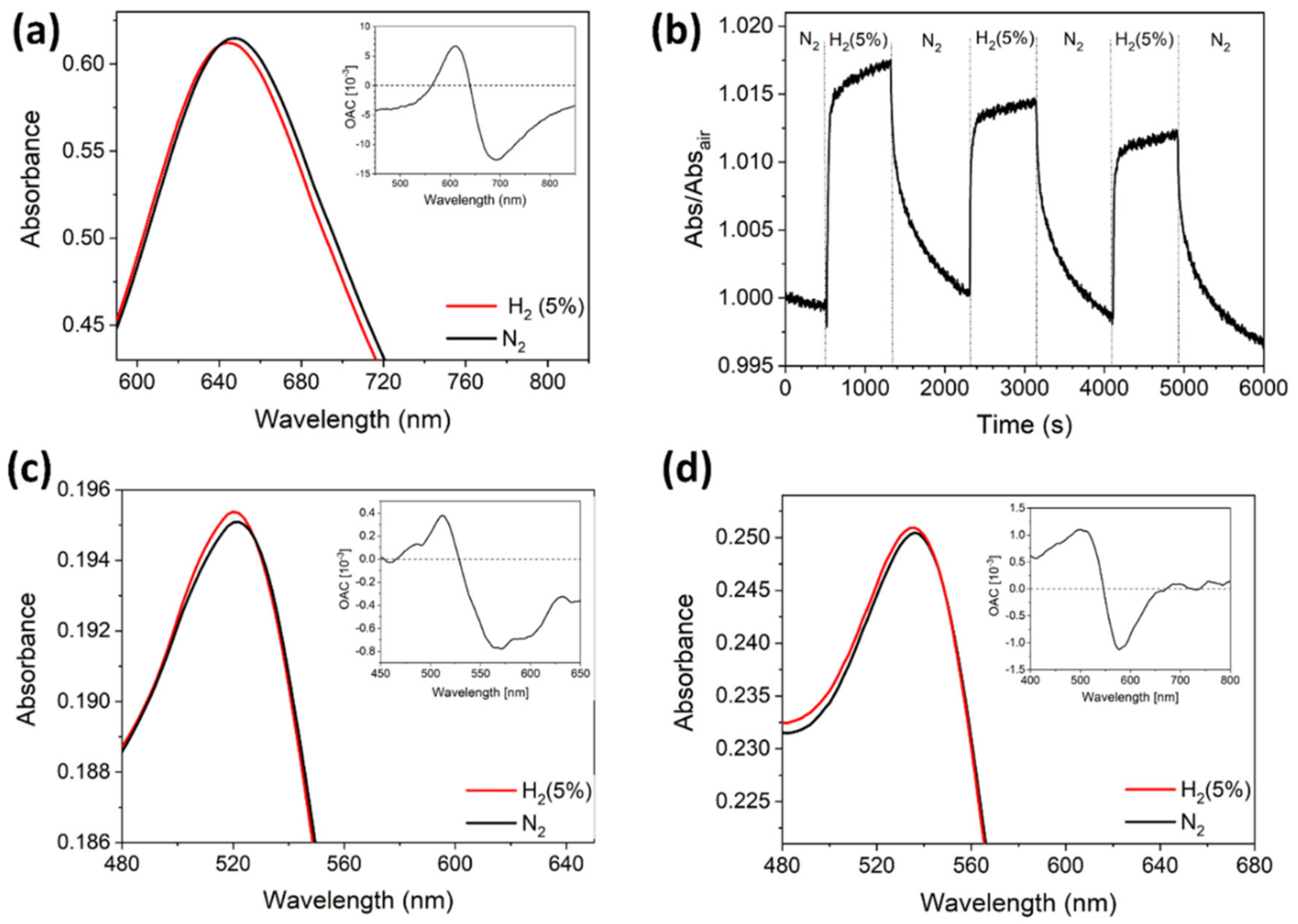
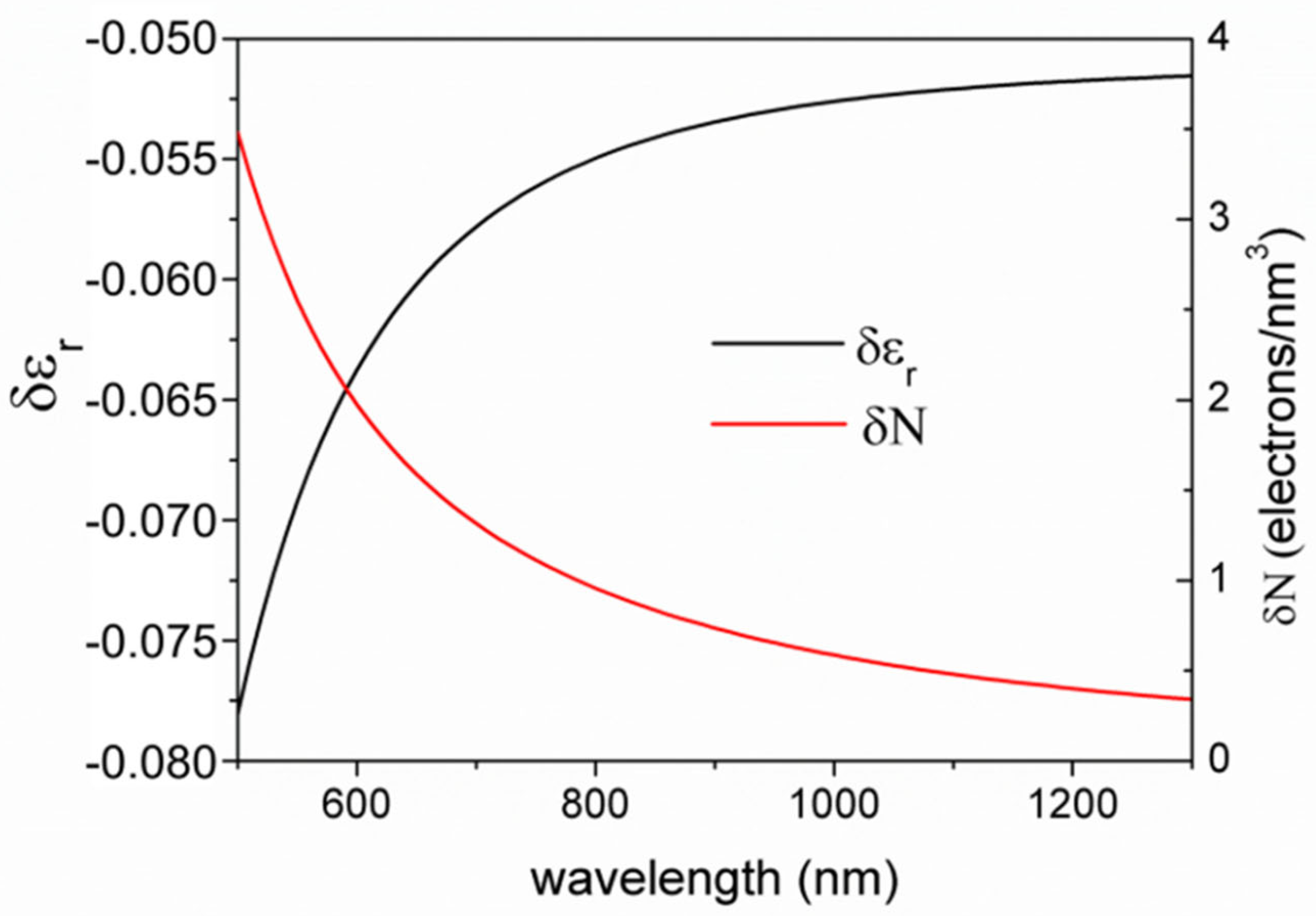
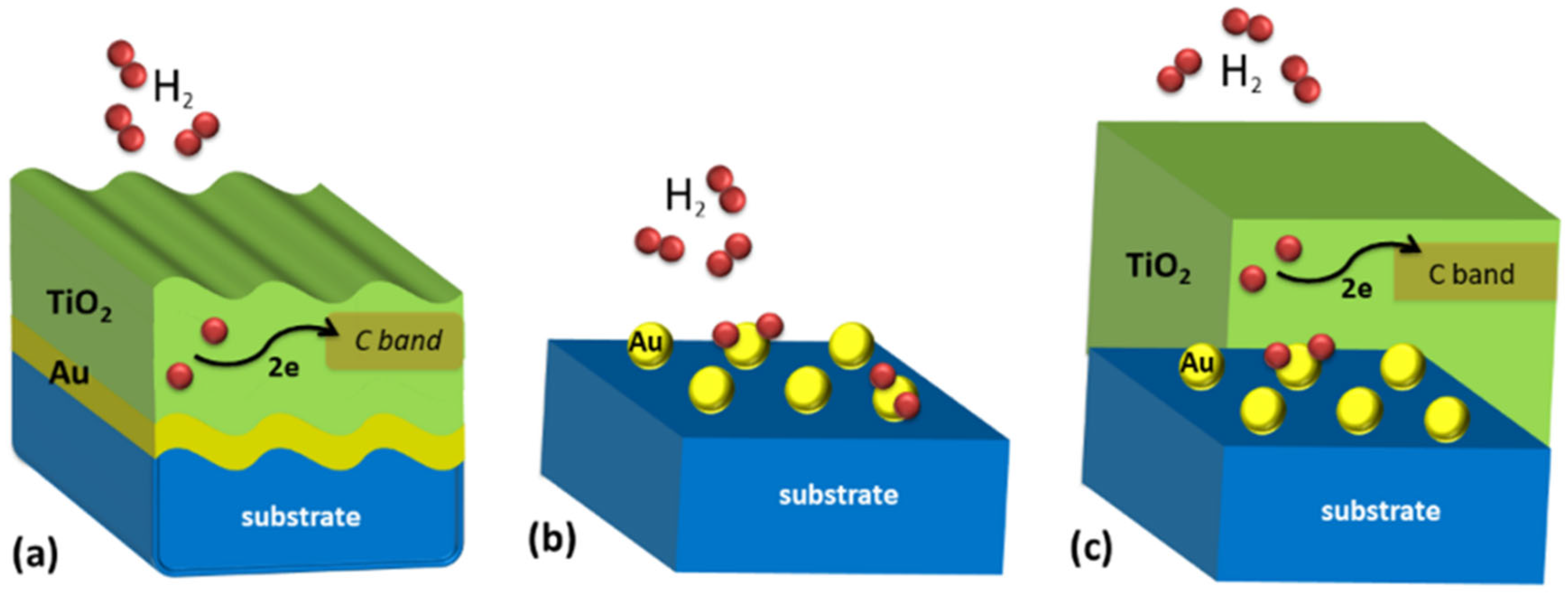
| SPP Dip [nm] | H2 | Shift [nm] | δεr | δN [nm−3] |
|---|---|---|---|---|
| 700 nm | 1% | −2.9 ± 0.1 | −0.03 | 0.6 |
| 700 nm | 5% | −4.5 ± 0.2 | −0.045 | 1 |
| 1240 nm | 1% | −0.9 ± 0.2 | −0.015 | 0.1 |
| 1240 nm | 5% | −2.2 ± 0.1 | −0.04 | 0.3 |
| Structure | LSPR Position in N2 [nm] | LSPR Position in 5% H2 [nm] | Shift [nm] |
|---|---|---|---|
| Au | 521.1 ± 0.1 | 519.7 ± 0.1 | −1.4 ± 0.2 |
| Au-SiO2 | 536.0 ± 0.1 | 534.9 ± 0.1 | −1.1 ± 0.1 |
| Au-TiO2 | 647.9 ± 0.1 | 645.0 ± 0.1 | −2.9 ± 0.2 |
© 2020 by the authors. Licensee MDPI, Basel, Switzerland. This article is an open access article distributed under the terms and conditions of the Creative Commons Attribution (CC BY) license (http://creativecommons.org/licenses/by/4.0/).
Share and Cite
Gazzola, E.; Cittadini, M.; Angiola, M.; Brigo, L.; Guglielmi, M.; Romanato, F.; Martucci, A. Nanocrystalline TiO2 Sensitive Layer for Plasmonic Hydrogen Sensing. Nanomaterials 2020, 10, 1490. https://doi.org/10.3390/nano10081490
Gazzola E, Cittadini M, Angiola M, Brigo L, Guglielmi M, Romanato F, Martucci A. Nanocrystalline TiO2 Sensitive Layer for Plasmonic Hydrogen Sensing. Nanomaterials. 2020; 10(8):1490. https://doi.org/10.3390/nano10081490
Chicago/Turabian StyleGazzola, Enrico, Michela Cittadini, Marco Angiola, Laura Brigo, Massimo Guglielmi, Filippo Romanato, and Alessandro Martucci. 2020. "Nanocrystalline TiO2 Sensitive Layer for Plasmonic Hydrogen Sensing" Nanomaterials 10, no. 8: 1490. https://doi.org/10.3390/nano10081490
APA StyleGazzola, E., Cittadini, M., Angiola, M., Brigo, L., Guglielmi, M., Romanato, F., & Martucci, A. (2020). Nanocrystalline TiO2 Sensitive Layer for Plasmonic Hydrogen Sensing. Nanomaterials, 10(8), 1490. https://doi.org/10.3390/nano10081490







